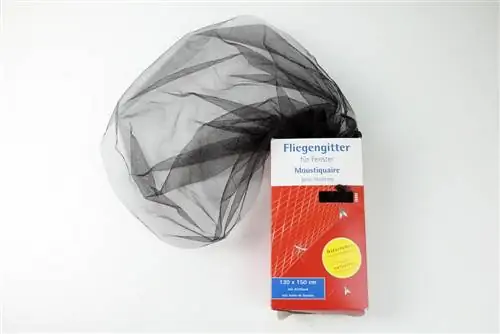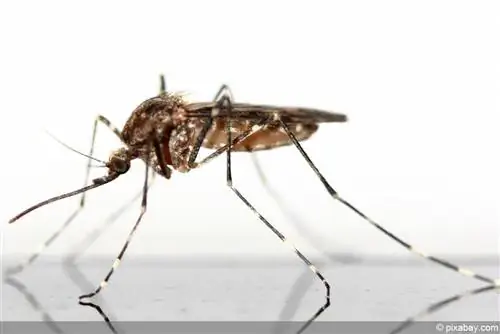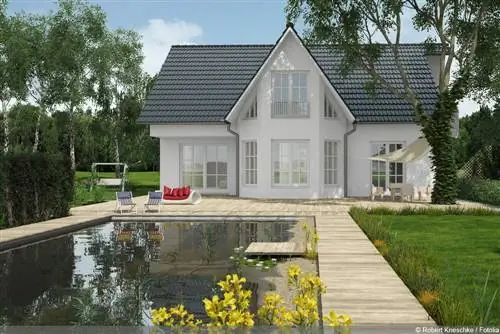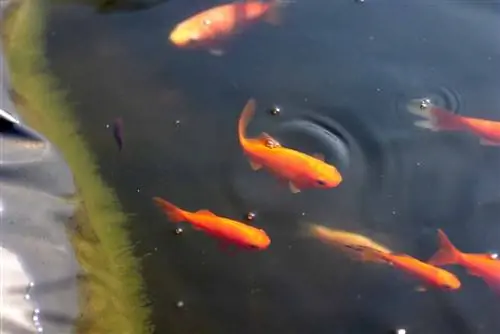- Author admin [email protected].
- Public 2023-12-17 03:39.
- Last modified 2025-01-24 12:45.
Mosquitoes (Culicidae), with their intrusiveness and hunger for human blood, are probably one of the most unpleasant visitors to your home garden. They prefer standing water to lay their eggs and can therefore easily reproduce in large numbers, making summer at the garden pond a real torture. In order to still be able to enjoy the rippling water in a relaxed manner, you should fight the mosquito larvae.
Cause: mosquito larvae
A mosquito plague occurs over a period of several weeks as long as the animals have sufficient breeding places available. Unfortunately, many of these can be found in German gardens because of the abundance of water available. Rain barrels are particularly popular with the Culicidae; they provide a safe and undisturbed environment for the larvae. But the garden pond is also extremely popular and represents an effective breeding ground for insects if the following properties exist:
- Water surface is undisturbed
- Water temperatures from around 15°C
The water quality is unimportant for the animals and they can actually use any type of pond as a breeding place. No matter whether it is a Japanese ornamental pond filled with clear water or a tiny natural pond, the mosquito larvae can survive anywhere. The female mosquitoes lay several hundred eggs on the surface of the water until the clearly visible larvae hatch and stay upside down in the same place in the garden pond for around three to four weeks. After this time the cycle starts again, but you can efficiently protect your pond from infestation.
Tip:
Mosquito eggs can survive even the winter. To do this, they are placed in moist soil and the defrost water and the warming in spring then cause the first, annoying swarms of mosquitoes, which can sometimes even appear during particularly mild winter months.
Prevention
Before you have to resort to all sorts of remedies, it is advisable to efficiently prevent mosquitoes from breeding. This means that you have to equip your pond in such a way that the pests are deprived of breeding grounds, which severely limits the population. Although this cannot always prevent all mosquito larvae, there are far fewer than usual. The following methods are suitable for this:
Skimming
Skimming the mosquito larvae is quick and easy and enables targeted minimization of the possible population. Since the larvae remain on the surface for quite some time after hatching, you can simply skim them off with a fine-mesh net and dispose of them in a dry plastic bag. You can recognize the mosquito larvae by the following features:
- small, black larvae in the water
- move in twitching movements
- hanging upside down
- escape if the water is disturbed
To do this, simply dip the net into the garden pond and walk along the surface once to catch a large amount of mosquito larvae. Of course, pay attention to the other pond inhabitants and plants. Depending on the size of the pond, this process can take quite a long time, but it can collect numerous mosquito larvae.
Tip:
You can use the caught larvae as food for aquarium fish. Simply add these to the aquarium in small quantities.
fly screen

Fly screens can be used not only for the apartment, but also for the garden pond. While this is not an ideal solution, especially if you have other pond inhabitants such as fish, the mosquitoes will not be able to lay eggs if they cannot reach the water. To do this, choose a fine-mesh fly screen that mosquitoes cannot get through. The fly screen should also be UV-resistant as it is constantly exposed to the sun. This could cause it to become brittle, leading to small cracks through which the bloodsuckers could get through. This method is best for extremely warm days.
CO2 trap
With a CO2 trap you can capture and kill numerous mosquitoes before they even reach your garden pond. The fully automated trap works as follows:
- the trap is set up in close proximity to the garden pond
- it is connected to a standard CO2 gas bottle and switched on
- the machine emits CO2 and attractants that attract mosquitoes
- they then fly close to the machine, are sucked in and killed
- No other insects are killed, such as butterflies or bees, because the suction mechanism is designed for mosquitoes
Although the machine does not work directly against mosquito larvae, the mosquito population is permanently reduced because the adults are killed.
Fighting mosquito larvae
If you are constantly plagued by mosquitoes that use your garden pond as a breeding ground, you should fight them directly as soon as the preventive measures are no longer sufficient. Particularly in warm, humid areas, the buzzing vampires multiply at record speed and these measures often do not help. Then the only measures left are that directly address the mosquito larvae and combat them permanently.
Fish
Your larval infestation is particularly easy to solve if you bring fish into the pond. Numerous species prefer to feed on mosquito larvae and you can even tackle large populations with the right types of fish. When choosing, you obviously have to consider choosing small species that fit into your pond. The smaller your pond is, the smaller the fish must be so that they can be kept appropriately. The best mosquito hunters therefore include:
- Goldfish
- Goldorfen
- Moderlieschen
- Minnows
- Rudd
- Roach

You can use any fish that interests you, but they have to be omnivorous or carnivorous in order for them to be interested in the larvae. Once you have decided on a species, you can find it either in a specialist retailer or a pet shop and release it into the pond. One advantage of this measure: when mosquito populations are high, the larvae are often sufficient as feed for the fish.
Surface tension
Mosquito larvae need a calm water surface to develop, which you can use to your advantage. However, it is not enough to walk your hand through the pond several times a day; constant movement must take place here. Even if only small parts of the pond are completely quiet, the mosquitoes can use this area to lay eggs. Here you can either use a fountain or fountains, as these constantly move the water and break the surface tension.
Bacillus Thuringiensis Israelensis
Bacillus Thuringiensis Israelensis is a harmless biocide that has been proven effective in the fight against mosquito larvae for years. The Israeli researcher Joel Margalit discovered this bacterium in the 1970s and it is particularly useful as a remedy against the larvae. A big advantage of the bacterium is that it specializes in mosquito larvae. Other pond inhabitants are not harmed by the product and even one tablet is enough for a garden pond with around 1,000 liters of water. The following products are recommended:
- Neudorff Neudomück
- Culinex Tab plus
When using, follow the manufacturer's instructions to avoid using too much or too little of the bacteria.
Water hoses
An interesting method of combating mosquito larvae in the garden pond is using water hoses. The waterskins (Bot. Utricularia) are the most species-rich group of carnivores and they have a ravenous appetite for the annoying pests. They feed on organisms that live in water and have developed an effective system to get to their prey:
- Plant forms long shoots in water
- she swims in the water and doesn't settle on the bottom
- the shoots form leaves between which there are small air bubbles
- the bubbles represent a trap for mosquito larvae and other small organisms
- If the larvae are caught by the water hoses, they can no longer escape and are “consumed”
Water hoses carry out this task rigorously and within a short time, the population of mosquito larvae decreases many times over. For one square meter you need between four and six plants, which, if there is enough food, stick out of the water with their yellow flowers and, in addition to their activity as a “predator”, also represent a pretty accent in the pond.
Dragonflies
It's worth incorporating plants into your pond that attract dragonflies. Dragonflies feed exclusively on other creatures and aquatic larvae are also on the menu. For this reason, you should consider placing one or two plants in the pond so that dragonflies can settle there. These plants include:
- Hornwort (bot. Ceratophyllum submersum)
- Milfoil (bot. Myriophyllum spicatum)
In addition, the pond should not be deeper than 20 centimeters and should not contain any fish, as dragonflies also eat fish. The dragonflies are a good environmentally friendly method.






